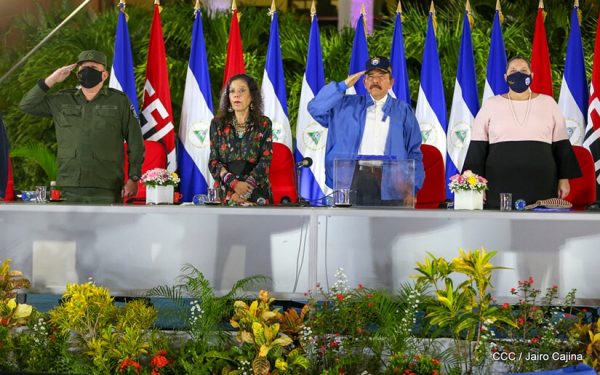Daniel Ortega’s Anti-Imperialist Disguise

Why doesn’t Ortega rant against CAFTA, US investments, or against the IDB and World Bank loans?
By Enrique Saenz (Confidencial)
HAVANA TIMES – Starting last year, the US government began to pound Ortega’s personal wealth. The sanction to the Corporative Bank (BanCorp), destroyed the financial arm of the business conglomerate owned by the dictator and broke the pipeline for the flow of money of dubious origin.
This was followed by sanctions against the Nicaraguan Petroleum Distributor, a company that had magically gone from being a state property to the private property of the ruling family. This business generated millions of dollars, multiplied by the surcharges that for years they imposed on fuels. They continue to receive some dirty revenues from this business, but the flow is less.
The most recent blow was for the savings and loan CARUNA, which guarded part of the Ortega family wealth. According to BANCORP’s audit corresponding to 2018, the trusts assigned to BANCORP exceeded 2,700 million dollars.
Faced with these blows, a furious Ortega, dusted off the old tirades and banners against imperialism, which were kept hidden for several years. And now he waves them furiously whenever he can.
Lets’s analyze the dictator’s new anti imperialist disguise
The first thing to keep in mind is the dependency of Nicaragua’s economy regarding the US empire widened and deepened during the “antiimperialist Ortega” regime. As usual, I will rely on official data.
Let’s start with exports. It turns out that the United States is the main destination for Nicaraguan exports. Plus, the aggregate that most of the products enter duty-free under the free trade agreement, known as CAFTA. A treaty promoted and signed by former President Bolanos and that benefitted the Nicaraguan economy and exporters. However, it also bolstered Ortega’s handling of the economy during these 14 years in power.
Here are some figures. In 2019, exports to the United States were 1.255 billion dollars, which is 47% of Nicaragua’s total exports. And what is happening in 2020? Well, we are on the way to 50% in August, according to the Central Bank, now with 48%.
And, what was the percentage before Ortega? In 2006 they represented 32% of the total.
What do we export? Nicaraguan exporters sell a variety of products: coffee, bananas, sugar, meat, peanuts, lobsters, cheese, tobacco, fish, gold, etc. This represents foreign currency, economic activity, employment, and revenue.
Free trade zones and exports to the US
Has anyone heard the anti-imperialist Ortega tirade against CAFTA? Nope.
Now let’s move on to free trade zones. More than one hundred thousand Nicaraguan workers, mainly women, support their families working very hard in the halls of these facilities. According to the Central Bank, in 2019, 2.13 billion dollars were exported to the United States. More than 75% of the free trade zones production.
In other words, almost all jobs in the free trade zones depend on sales to the US.
What about foreign investment? Anti-imperialist theorists point to investments as one of the main features and mechanisms of imperialism. In his recent speeches, Ortega has referred to “pillaging.”
It turns out that the most recent data published by the government’s ProNicaragua shows that US investors lead the list of the main investment flows.How about tourism?
Furthermore, the same institution, stated in a press release: “Ten years after the entry into effect of the Dominican Republic-Central America Free Trade Agreement (DR-CAFTA), commerce between Nicaragua and the United States has shown an outstanding growth rate. In the 2006-2015 period, Nicaraguan exports to the United States increased by approximately 170 percent and US investment in the country has grown by an impressive 414 percent.”
Has anyone heard the anti-imperialist Ortega tirade against free trade zones and US investments? Nope.
How about tourism?
The data from the last normal year in terms of tourism pertain to 2017. During that year, 367,000 tourists from the United States arrived in the country. How many small, micro and medium companies, restaurants and hotels of all sizes have benefited from US tourism?
Let’s move on to family remittances. Official figures indicate that in 2019, remittances from the United States reached 930 million dollars, which represents 55% of the total. By August of this year they had already reached 709 million dollars, which represents 60%. In 2007, remittances from the United States did not reach 600 million dollars for the year.
Let’s do the math: 1.255 billion dollars in exports of goods; 2.130 billion in exports from free trade zones; 930 million dollars in remittances, totaling 4,315 billion dollars. To that we added 367,000 tourists in 2017; plus investments, plus credits from the IDB and the World Bank, where the United States is the main partner. Now Let us contrast those figures with the 2019 Gross Domestic Product: US $ 12.500 billion.
What percentage of the domestic product does the economic relations with the United States represent?
The anti-imperialist relies more on the US
Contradictorily, the anti-imperialist turned out worse than the neoliberals in deepening the dependency of the Nicaraguan economy vis-à-vis the empire.
This data gives rise to at least two questions. Is it that Ortega ignores these figures and because of that looks ridiculous ranting against imperialism? Or is it that he knows them very well and is a perfect hypocrite who yells only to be applauded by his spectators?
What do you think?
In conclusion, when we listen to the speeches of the dictator ranting and raving against imperialism, we must ask ourselves why he does not rant against CAFTA, or against US investments, or against IDB and World Bank loans, or against North American tourists, or against exports from free zones, or against remittances. Even the Army has taken its good portion from gringo cooperation.
For the record. Here I am expressing neither sympathy nor antipathy towards the United States. This is cold data. Figures that reveal another of the dictator’s lies.




